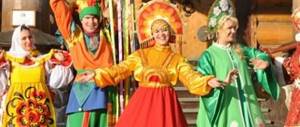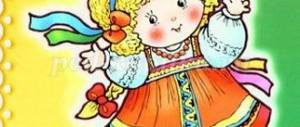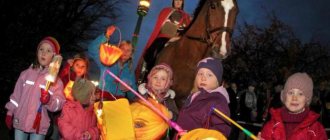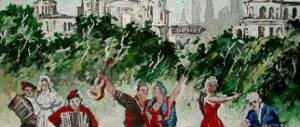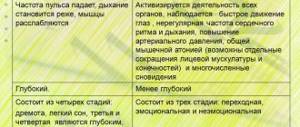History of folklore
Oral folk art (folklore) existed even in the pre-literate era. Works of folklore (riddles, tongue twisters, fables, etc.) were transmitted orally. They memorized them by ear. This contributed to the emergence of different versions of the same folklore work. Folklore continued to develop after the spread of written literature, remaining an important element of ancient Russian culture.
The term “folklore” was first introduced by the English scientist William Thoms in 1846 to designate both the artistic (legends, dances, music, etc.) and material (housing, utensils, clothing) culture of the people.
Russian folklore is the collective name for works of Russian oral folk art (folklore). Russian folklore was passed down from generation to generation in the form of songs or tales, the authorship of which has not been preserved. The length of works of Russian folklore varies from epic epics to short proverbs. The study of Russian folklore began in the 19th century.
Genres of folklore
The following genres of folklore are distinguished:
- Epics
- Bylichka
- Byvalshchina
- Tall tale
- Russian tales
- Russian proverbs and sayings
- Conspiracies
- Ritual songs (Vinogradye, Podblyudnye songs, Trinity-Semitic, Kupala, Stubble, etc.)
- Ditties
- Historical legends
- Small genres of folklore
Small genres of folklore are folklore works that are small in volume. In some works the definition of children's folklore is found, since such folk works enter a person's life very early, long before mastering speech.
Lullaby
The lullaby is one of the oldest genres of folklore, as evidenced by the fact that it retains elements of a charm-charm.
People believed that a person is surrounded by mysterious hostile forces, and if a child sees something bad and scary in a dream, then in reality it will not happen again. That is why you can find the “little gray wolf” and other frightening characters in the lullaby. Later, lullabies lost their magical elements and acquired the meaning of good wishes for the future. So, a lullaby is a song used to lull a child to sleep. Since the song was accompanied by the measured swaying of the child, rhythm is very important in it.
Pestushka
Pestushka (from the word to nurture, that is, to nurse, groom) is a short poetic chant of nannies and mothers, with which they accompany the actions of a child that he performs at the very beginning of his life. For example, when the child wakes up, the mother strokes and caresses him, saying:
Stretch, grow, Across the fat, And in the hands of the fat, And in the mouth, And in the head, the mind.
When a child begins to learn to walk, they say:
Big feet Walked along the road: Top, top, top, Top, top, top.
Nursery rhyme
A nursery rhyme is an element of pedagogy, a song-sentence that accompanies playing with a child’s fingers, arms and legs. Nursery rhymes, like pesters, accompany the development of children. Small rhymes and songs allow you to encourage the child to take action in a playful way, while simultaneously performing massage, physical exercises, and stimulating motor reflexes.
This genre of children's folklore provides incentives to play out the plot using fingers (finger games or Ladushki), hands, and facial expressions. Nursery rhymes help instill in a child the skills of hygiene, order, and develop fine motor skills and the emotional sphere.
Examples:
“Magpie” Magpie-crow, (running his finger over his palm) Magpie-crow, Gave it to the children. (curls fingers) She gave it to this one, she gave it to this one, she gave it to this one, she gave it to this one, but she didn’t give it to this one: - Why didn’t you cut wood? - Why didn’t you carry water?
joke
A joke (from bayat, that is, to tell) is a poetic, short, funny story that a mother tells to her child, for example:
Owl, owl, owl, Big head, sat on a stake, looking to the sides. Proverbs A spoon is on its way to dinner. You can’t even pull a fish out of a pond without difficulty. The eyes are afraid, but the hands are doing. A rolling stone gathers no moss. There is no need for treasure if there is harmony in the family. Don't have 100 rubles, but have 100 friends. An old friend is better than two new ones. A friend in need is a friend indeed. If I had known where you would fall, I would have laid out straws. The Motherland is your mother, know how to stand up for her. The master's work is afraid.
Games
There were special songs for the games.
Games could be:
Kissing , as a rule, these games were played at parties and get-togethers (usually ending with a kiss between a young guy and a girl);
Ritual , such games were characteristic of some kind of ritual, holiday. For example, Maslenitsa festivities (typical fun: removing a prize from the top of a pole, tug of war, competitions for dexterity, strength);
Seasonal , especially common among children, especially in winter. We played the so-called “Warmers”: the leader shows some movements, and everyone else repeats. Or the traditional “collar” and “stream”.
Calls
Invocations are one of the types of invocational songs of pagan origin. They reflect the interests and ideas of peasants about the economy and family. For example, the spell of a rich harvest runs through all the calendar songs; For themselves, children and adults asked for health, happiness, and wealth.
The chants are an appeal to the sun, rainbow, rain and other natural phenomena, as well as to animals and especially often to birds, which were considered the harbingers of spring. Moreover, the forces of nature were revered as living: they make requests for spring, wish for its speedy arrival, and complain about winter.
Larks, larks! Fly to us, Bring us a warm summer, Take away a cold winter from us. We are tired of the cold winter, our hands and feet are frozen.
Counting book
A counting rhyme is a form of drawing lots that is used to determine who leads the game. A counting table is an element of the game that helps establish agreement and respect for the accepted rules. Rhythm is very important in organizing a counting rhyme.
Aty-baty, the soldiers were going, Aty-baty, to the market. Atty-batty, what did you buy? Aty-bati, samovar, etc.
Patter
A tongue twister is a phrase built on a combination of sounds that make it difficult to quickly pronounce words. Tongue twisters are also called “pure twisters” because they contribute and can be used to develop diction. Tongue twisters can be both rhymed and non-rhymed.
Greek rode across the river. He sees a Greek: there is a cancer in the river, He put the Greek’s hand into the river - The cancer grabs the Greek’s hand - claw! The bull was blunt-lipped, the bull was blunt-lipped, the bull's white lip was dull. From the clatter of hooves, dust flies across the field.
Mystery
A riddle, like a proverb, is a short figurative definition of an object or phenomenon, but unlike a proverb, it gives this definition in an allegorical, deliberately obscure form. As a rule, in a riddle, one object is described through another based on similar features: “The pear is hanging - you can’t eat it” (lamp). A riddle can also be a simple description of an object, for example: “Two ends, two rings, and a nail in the middle” (scissors). This is both a folk pastime and a test of ingenuity and intelligence.
The role of riddles and jokes was also played by inverted fables, which for adults appear as absurdities, but for children - funny stories about what does not happen, for example:
From behind the forest, from behind the mountains, Grandfather Egor is coming. He is on a gray cart, on a creaking horse, belted with an axe, a belt tucked into his belt, boots wide open, a zipun on his bare feet.
Songs, epics, fairy tales and other types of CNT testify to the richness and diversity of the folklore of Ancient Rus'.
Research on folklore
First of all, I conducted a survey on issues that concerned me during this study. (Appendix No. 1.)
Population survey results:
(25 people of different ages, social status, education were interviewed)
1 question
95% answered that they know what folklore is
5% answered that they find it difficult to answer in the correct literary language, but they can guess what it is. At the same time, they gave examples of different genres of CNT.
Question 2
100% answered that they like folklore
Question 3
93% - constantly tell their children, brothers, sisters, grandchildren, etc. something from folklore;
5% - rarely tell;
2.5% - never use folklore genres
Question 4
100% answered that folklore is needed:
Lullabies, fairy tales, nurseries, sayings for the amusement of young children; games, riddles, tongue twisters for entertainment; ritual songs for knowledge of one’s history, “roots”
Question 5
97.5% - are ready to continue the traditions of our people (not to forget folklore); 2.5% - found it difficult to answer this question
Conclusions from this survey:
Firstly, I would like to note that everyone, without exception, responded to participation in the survey with great interest and enthusiasm.
Secondly, I was amazed to learn how often people of different generations use folklore genres in their daily lives.
I would like to note that the works of CNT are an unbreakable chain that connects generations (especially grandmothers and grandchildren).
The most important thing is that people are ready to continue the traditions of our people and do everything so that subsequent generations do not lose interest in folklore.
I also noticed that lullabies evoke special feelings of love and awe in people.
I decided to go further and conduct interviews among the fathers and mothers, grandparents of my friends and peers. They sang to me a few lines from the lullabies they used to put their children and grandchildren to bed. The results of this interview are presented below (Appendix No. 2).
When processing the results of this interview, I made the following conclusions:
- Lullabies are one of the favorite types of folklore;
- Everyone, without exception, has used them or is still using them in their daily lives;
- All lullabies are based on “unusual vocabulary”: affectionate words, many words with diminutive suffixes; All lullabies have a special rhythm, melodiousness, and melody.
- Children who hear lullabies as they fall asleep (the gentle voice of their mother or grandmother, their warm hands) feel care, safety, and love.
The main conclusion: lullabies have enormous potential for a child’s development from the very first days of life.
Conclusion
In conclusion, I would like to add that our hypothesis was completely confirmed: folklore is interesting, relevant today, and it is absolutely possible to revive interest in folklore among the younger generation.
When summing up the results of our study, the following conclusions were drawn:
- Our contemporaries are interested in folklore in all its manifestations;
- People want to convey, first of all, their knowledge in this field to the younger generation (and pass it on “by word of mouth”, as was the case before);
- And today people understand the relevance of folklore, its aesthetic significance for communication between generations, its necessity in everyday life, in everyday life.
- Folklore was, is and will be!
The practical output of our work will be the activities planned in the objectives of our research work (see above)
Bibliography
- “Book for reading to children” - Tula “Rodnichok” Moscow Publishing house AST - 2005
- “Literature” textbook for grade 5 – V.Ya. Korovin Publishing house "Prosveshcheniye" - 2012
- “Favorite reading” - Moscow AST Publishing House
- “Proverbs and sayings of the Russian people” - Moscow - 2008
- “Explanatory Dictionary of the Russian Language” by S.I. Ozhegov, N.Yu. Shvedova Moscow - 2005
Appendix No. 1. Questionnaire
- What is folklore?
- What is folklore? (examples)
- What have you heard from the older generation from the ONT (oral folk art)?
- Do you like works of folklore? If yes, which ones?
- Do you yourself use folklore genres when communicating with brothers and sisters, children, parents, friends (depending on the age category)?
- Can you tell us some folklore?
- Why do you think folklore is needed? What replaces it these days? Does he have a future?
- Are you ready to continue the traditions of our people and not forget folklore?
If you liked the page, share it on social networks:
Project on the topic “Children’s folklore”
MBOU Mikhailovskaya OSH
Korevsky branch
PROJECT
on this topic:
Completed by: 6th grade student
RODIONOV ILYA.
This project on the topic “Folklore” provides accessible information about the history of folklore and its genres. The work defines such small genres of folklore as a lullaby, pestushka, nursery rhyme, joke, chant, riddle, tongue twister, counting rhyme.
Works of folk art accompany a person from birth. They contribute to the formation and development of the child. Therefore, the author carried out activities aimed at familiarizing school students with the genres of folklore. The program of events consisted of an exhibition of drawings, folklore games, preparation and release of a collection of works by UNT.
Table of contents
Introduction 1. What is folklore. 2. History of folklore. 3. Genres of folklore. 4. Small genres of folklore. 4.1. Lullaby 4.2. Pestushka. 4.3. Nursery rhyme. 4.4. A joke. 4.5. Proverbs. 4.6. Games. 4.7. Calls. 4.8. Counting book. 4.9. Patter. 4.10. Mystery. Conclusion References Appendix
Introduction
Folklore
(from the English folk-lore - “ folk wisdom ”) is folk art, most often oral.
Artistic, collective, creative activity of the people, reflecting their life, views, ideals, principles; poetry created by the people and existing among the masses (legends, songs, ditties, anecdotes, fairy tales, epics), folk music (songs, instrumental tunes and plays), theater (dramas, satirical plays, puppet theater), dance, architecture, fine and arts and crafts.
The most important feature of folklore, in contrast to literature and modern book culture, is its traditionalism and orientation towards the oral method of transmitting information. The carriers were usually rural residents (peasants).
Problem : people forget folklore, turning less and less to small genres of oral folk art.
Object of study : works of small genres of CNT (in particular lullabies).
Purpose of the study : to analyze the attitude of our contemporaries to folklore, to arouse interest in small genres of CNT.
Tasks:
- Conduct a survey among the population on attitudes towards small genres of folklore in our area;
- Identify gaps in knowledge of these types of CNTs;
- Organize a number of folklore events among students of different classes on this topic;
- Conduct training for junior school children in outdoor folklore games;
- Make an exhibition of drawings on this topic;
- Conduct interviews among the “ adult population ” (Collect materials, using the example of lullabies (texts), draw conclusions.)
- To release a collection of small genres of folklore “ Grandmother’s Treasury ” (based on the memories of grandparents).
Hypothesis : I believe that folklore is interesting, relevant today, and it is absolutely possible to revive interest in folklore among the younger generation.
We used the following
methods:
- Observation and collection of information;
- Working with different sources of information (books, dictionaries, textbooks, Internet resources, etc.);
- Systematization of research results;
- Summarizing.
Expected results:
- I find out the attitude of the population towards small genres of folklore in our area;
- I will draw conclusions whether it is true that small genres of folklore are a “ bringing link ” between generations and serve as an important point in the education and formation of the personality of a growing person.
- Identify how you can arouse interest in folklore;
- Organize a number of folklore events aimed at solving our task.
What is folklore
Folk art , which originated deep in antiquity, is the historical basis of the entire world artistic culture, the source of national artistic traditions, and a way of expressing national self-awareness.
A precise definition of the term " folklore " is difficult, since this form of folk art is not immutable and ossified. Folklore is constantly in the process of development and evolution.
History of folklore
Oral folk art (folklore) existed even in the pre-literate era. Works of folklore (riddles, tongue twisters, fables, etc.) were transmitted orally. They memorized them by ear. This contributed to the emergence of different versions of the same folklore work. Folklore continued to develop after the spread of written literature, remaining an important element of ancient Russian culture.
The term “folklore”
was first introduced by the English scientist William Thoms in 1846 to designate both the artistic (legends, dances, music, etc.) and material (housing, utensils, clothing) culture of the people.
Russian folklore
is the collective name for works of Russian oral folk art (folklore).
Russian folklore was passed down from generation to generation in the form of songs or tales, the authorship of which has not been preserved. The length of works of Russian folklore varies from epic epics to short proverbs. The study of Russian folklore began in the 19th century. Genres of folklore
The following genres of folklore are distinguished:
- Epics
- Bylichka
- Byvalshchina
- Tall tale
- Russian tales
- Russian proverbs and sayings
- Conspiracies
- Ritual songs (Vinogradye, Podblyudnye songs, Trinity-Semitic, Kupala, Stubble, etc.)
- Ditties
- Historical legends
- Small genres of folklore
Small genres of folklore
are folklore works that are small in volume.
In some works the definition of children's folklore is found, since such folk works enter a person's life very early, long before mastering speech. Lullaby
The lullaby
is one of the oldest genres of folklore, as evidenced by the fact that it retains elements of a charm-charm.
People believed that a person is surrounded by mysterious hostile forces, and if a child sees something bad and scary in a dream, then in reality it will not happen again. That's why you can find the " little gray wolf " and other frightening characters in the lullaby. Later, lullabies lost their magical elements and acquired the meaning of good wishes for the future. So, a lullaby is a song used to lull a child to sleep. Since the song was accompanied by the measured swaying of the child, rhythm is very important in it.
Pestushka
Pestushka
(from the word to nurture, that is, to nurse, groom) is a short poetic chant of nannies and mothers, with which they accompany the actions of a child that he performs at the very beginning of his life.
For example, when the child wakes up, the mother strokes and caresses him, saying: Stretch, grow, Across the fat,
And in the hands of the veil, And in the mouth there is a talk, And in the head there is a mind.
When a child begins to learn to walk, they say:
Big feet Walked along the road: Top, top, top, Top, top, top.
Nursery rhyme
A nursery rhyme
is an element of pedagogy, a song-sentence that accompanies playing with a child’s fingers, arms and legs. Nursery rhymes, like pesters, accompany the development of children. Small rhymes and songs allow you to encourage the child to take action in a playful way, while simultaneously performing massage, physical exercises, and stimulating motor reflexes.
This genre of children's folklore provides incentives to play out the plot using fingers (finger games or Ladushki), hands, and facial expressions. Nursery rhymes help instill in a child the skills of hygiene, order, and develop fine motor skills and the emotional sphere.
Examples:
“Magpie” Magpie-crow, (running his finger over his palm) Magpie-crow, Gave it to the children. (curls fingers) She gave it to this one, she gave it to this one, she gave it to this one, she gave it to this one, but she didn’t give it to this one: - Why didn’t you cut wood? - Why didn’t you carry water?
joke
A joke
(from bayat, that is, to tell) is a poetic, short, funny story that a mother tells to her child, for example: Owl, owl, owl, Big head, Sat on a stake, Looking to the sides. Proverbs A spoon is on its way to dinner. You can’t even pull a fish out of a pond without difficulty. The eyes are afraid, but the hands are doing. A rolling stone gathers no moss. There is no need for treasure if there is harmony in the family. Don't have 100 rubles, but have 100 friends. An old friend is better than two new ones. A friend in need is a friend indeed. If I had known where you would fall, I would have laid out straws. The Motherland is your mother, know how to stand up for her. The master's work is afraid. Invocations Invocations
are
one of the types of invocation songs of pagan origin.
They reflect the interests and ideas of peasants about the economy and family. For example, the spell of a rich harvest runs through all the calendar songs; For themselves, children and adults asked for health, happiness, and wealth. The chants are an appeal to the sun, rainbow, rain and other natural phenomena, as well as to animals and especially often to birds, which were considered the harbingers of spring. Moreover, the forces of nature were revered as living: they make requests for spring, wish for its speedy arrival, and complain about winter.
Larks, larks!
Fly to us, Bring us a warm summer, Take away a cold winter from us. We are tired of the cold winter, our hands and feet are frozen.
Counting book
A counting rhyme
is a form of drawing lots that is used to determine who leads the game.
A counting table is an element of the game that helps establish agreement and respect for the accepted rules. Rhythm is very important in organizing a counting rhyme. Aty-baty, the soldiers were going, Aty-baty, to the market.
Atty-batty, what did you buy?
Aty-bati, samovar, etc. Patter
A tongue twister
is a phrase built on a combination of sounds that make it difficult to quickly pronounce words. Tongue twisters are also called “ pure twisters ” because they promote and can be used to develop diction.
Tongue twisters can be both rhymed and non-rhymed. Greek rode across the river. He sees a Greek: there is a cancer in the river, He put the Greek’s hand into the river - The cancer grabs the Greek’s hand - claw! The bull was blunt-lipped, the bull was blunt-lipped, the bull's white lip was dull. From the clatter of hooves, dust flies across the field.
Mystery
A riddle,
like a proverb, is a short figurative definition of an object or phenomenon, but unlike a proverb, it gives this definition in an allegorical, deliberately obscure form.
As a rule, in a riddle, one object is described through another based on similar features: “The pear is hanging - you can’t eat it” (lamp). A riddle can also be a simple description of an object, for example: “Two ends, two rings, and a nail in the middle” (scissors). This is both a folk pastime and a test of ingenuity and intelligence. The role of riddles and jokes was also played by inverted fables, which for adults appear as absurdities, but for children - funny stories about what does not happen, for example:
From behind the forest, from behind the mountains, Grandfather Egor is coming. He is on a gray cart, on a creaking horse, belted with an axe, a belt tucked into his belt, boots wide open, a zipun on his bare feet.
Songs, epics, fairy tales and other types of CNT testify to the richness and diversity of the folklore of Ancient Rus'.
Conclusion
In conclusion, I would like to add that our hypothesis was completely confirmed: folklore is interesting, relevant today, and it is absolutely possible to revive interest in folklore among the younger generation.
When summing up the results of our study, the following conclusions were drawn:
- Our contemporaries are interested in folklore in all its manifestations;
- People want to convey, first of all, their knowledge in this field to the younger generation (and pass it on “ by word of mouth ”, as was the case before);
- And today people understand the relevance of folklore, its aesthetic significance for communication between generations, its necessity in everyday life, in everyday life.
Bibliography
- “Book for reading to children” - Tula “Rodnichok” Moscow Publishing house AST - 2005
- “Literature” textbook for grade 5 – V.Ya. Korovin Publishing house "Prosveshcheniye" - 2012
- “Favorite reading” - Moscow AST Publishing House
- “Proverbs and sayings of the Russian people” - Moscow - 2008
- “Explanatory Dictionary of the Russian Language” by S.I. Ozhegov, N.Yu. Shvedova Moscow - 2005

